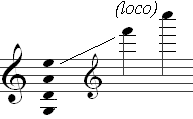
A mandolin is a stringed musical instrument in the lute family and is generally plucked with a pick. It most commonly has four courses of doubled strings tuned in unison, thus giving a total of eight strings. A variety of string types are used, with steel strings being the most common and usually the least expensive. The courses are typically tuned in an interval of perfect fifths, with the same tuning as a violin. Also, like the violin, it is the soprano member of a family that includes the mandola, octave mandolin, mandocello and mandobass.
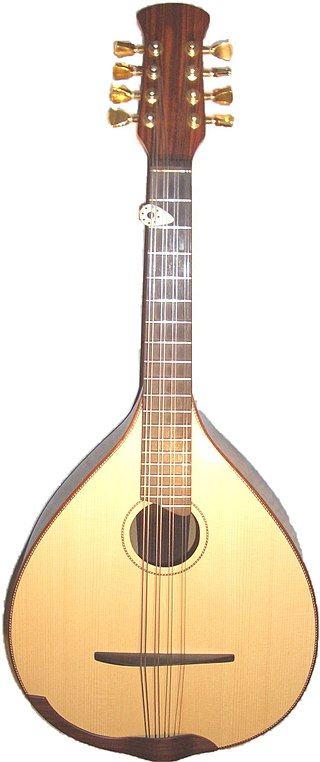
The mandola (US and Canada) or tenor mandola (Ireland and UK) is a fretted, stringed musical instrument. It is to the mandolin what the viola is to the violin: the four double courses of strings tuned in fifths to the same pitches as the viola (C3-G3-D4-A4), a fifth lower than a mandolin. The mandola, though now rarer, is an ancestor of the mandolin. (The word mandolin means little mandola.)
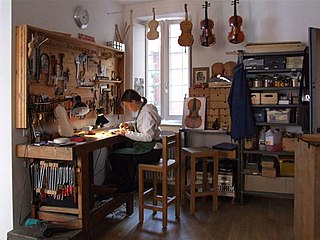
A luthier is a craftsperson who builds or repairs string instruments that have a neck and a sound box. The word luthier is originally French and comes from the French word for "lute". The term was originally used for makers of lutes, but it came to be used in French for makers of most bowed and plucked stringed instruments such as members of the violin family and guitars. Luthiers, however, do not make harps or pianos; these require different skills and construction methods because their strings are secured to a frame.

Orville H. Gibson was an American luthier who founded the Gibson Guitar Company in Kalamazoo, Michigan in 1902, makers of guitars, mandolins and other instruments.

The mandocello is a plucked string instrument of the mandolin family. It is larger than the mandolin, and is the baritone instrument of the mandolin family. Its eight strings are in four paired courses, with the strings in each course tuned in unison. Overall tuning of the courses is in fifths like a mandolin, but beginning on bass C (C2). It can be described as being to the mandolin what the cello is to the violin.
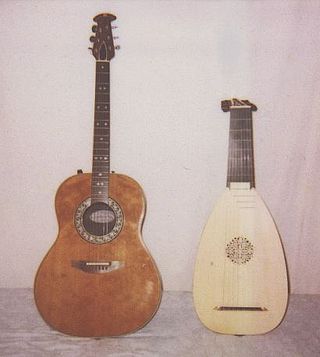
Plucked string instruments are a subcategory of string instruments that are played by plucking the strings. Plucking is a way of pulling and releasing the string in such a way as to give it an impulse that causes the string to vibrate. Plucking can be done with either a finger or a plectrum.

A mandolin orchestra is an orchestra consisting primarily of instruments from the mandolin family of instruments, such as the mandolin, mandola, mandocello and mandobass or mandolone. Some mandolin orchestras use guitars and double-basses instead of, or as well as, the lower mandolin-family instruments.

The Mandobass is the largest member of the mandolin family, sometimes used as the bass instrument in mandolin orchestras. It's essentially an Enormous Acoustic Bass shaped like an A Style Mandolin. This Bass is so large that players usually hold it like a double bass—upright and supported on an endpin that rests on the floor. The neck-scale length on a full-size mando-bass is similar to that of a standard orchestral double bass viol: about 43 inches (110 cm). The instrument is otherwise similar to the smaller, higher-pitched members of the mandolin family, having a fretted neck, a headstock with geared tuning machines, and a large resonating body often—but not always—shaped like other mandolins.

Raffaele Calace was an Italian mandolin player, composer, and luthier.

Giuseppe Pettine was an Italian-American concert mandolinist, teacher, and composer.
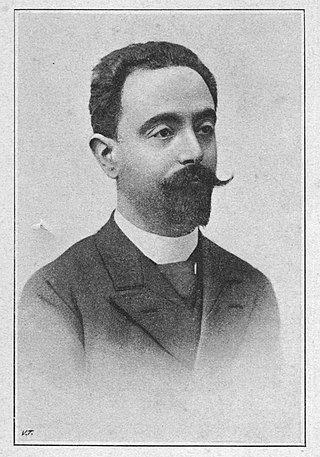
Carlo Munier (1858–1911) was an Italian musician who advocated for the mandolin's acknowledgement among as an instrument of classical music and focused on "raising and ennobling the mandolin and plectrum instruments". He wanted "great masters" to consider the instrument and raise it above the level of "dilettantes and street players" where it had been stuck for centuries. He expected that the mandolin and guitar would be taught in serious orchestral music schools and incorporated into the orchestra. A composer of more than 350 works for the mandolin, he led the mandolin orchestra Reale circolo mandolinisti Regina Margherita named for its patron Margherita of Savoy and gave the queen instruction on the mandolin. As a teacher, he wrote Scuola del mandolino: metodo completo per mandolino, published in 1895.

Antonio Luigi Embergher was an Italian luthier known for his high quality bowlback mandolins. Son of the ebanist Pietro Embergher and Maria Ciccarelli, Born in Arpino 1856.

Silvio Ranieri was an Italian Mandolin virtuoso. Born in Rome, he gave his first concert in 1897, aged fifteen, and he went on to tour Europe to great acclaim. It was his desire to elevate the Mandolin to a status similar to the violin in classical music, and he did much to contribute to the immense popularity of the mandolin in the 1920s. Later settling in Brussels he established a tradition of Mandolin music in northern Europe. He always played Mandolins produced by Luigi Embergher, which he compared to the Stradivarius violin in perfection. Ranieri once visited Embergher's shop in Rome and tried out an instrument marked Gold Medal Paris 1900. When he wanted to buy it the luthier replied that it was not for sale, but that he could play it at the evening recital. After the recital Embergher approached Ranieri and offered him the instrument as a gift.

A mandolone is a member of the mandolin family, created in the 18th century. It is a bass range version of the Neapolitan mandolin. Its range was not as good as the mandocello, which replaced it in mandolin orchestras, and had largely disappeared in the 19th century.
Ugo Orlandi is a musicologist, a specialist in the history of music, a university professor and internationally renowned mandolinist virtuoso. Among worldwide musicians, professional classical musicians are a small group; among them is an even smaller group of classical mandolinists. Among members of this group, Ugo Orlandi is considered "distinguished." Music historian Paul Sparks called him "a leading figure in the rehabilitation of the eighteenth-century mandolin repertoire, having recorded many concertos from this period."

Pasquale Vinaccia was an Italian luthier, appointed instrument-maker for the Queen of Italy, and maternal grandfather to Carlo Munier. In 1835 he improved the mandolin, creating a version of the instrument that used steel wires for strings, known today as the "Neapolitan Mandolin." His use of steel strings has become the dominant way of stringing mandolins.

Vincent Beer-Demander, born in Paris in 1982, is a French mandolinist and composer. He teaches at several music schools and numerous musical events, in France and abroad, in particular the Mandol'in Ariège festival, of which he was one of the main creators and organizers. His compositions are available from several music publishers.
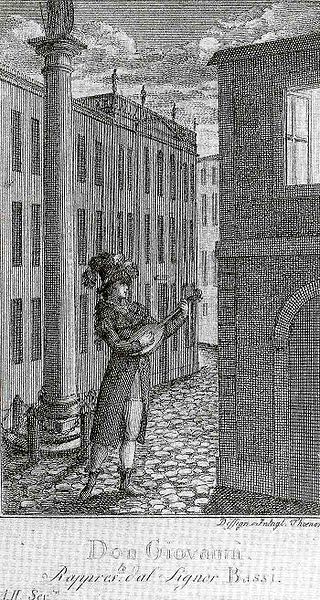
The mandolin is a modern member of the lute family, dating back to Italy in the 18th century. The instrument was played across Europe but then disappeared after the Napoleonic Wars. Credit for creating the modern bowlback version of the instrument goes to the Vinaccia family of Naples. The deep bowled mandolin, especially the Neapolitan form, became common in the 19th century, following the appearance of an international hit, the Spanish Students. They toured Europe and America, and their performances created a stir that helped the mandolin to become widely popular.

















